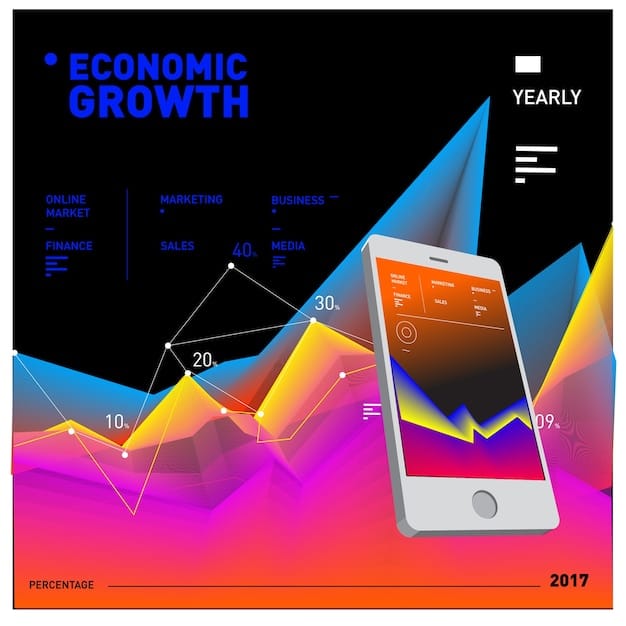Mobile Wallet Adoption: Capitalize on 40% US Growth by 2025

Mobile wallet adoption in the US is projected to grow by 40% by 2025, offering significant opportunities for businesses to capitalize on the increasing popularity of mobile payments through strategic implementation and enhanced user experience.
The rise of digital transactions is undeniable, and mobile wallets are at the forefront of this revolution. Understand how **mobile wallet adoption: capitalize on the projected 40% growth in mobile payments in the US by 2025**, and learn how to position your business for success.
Understanding the Mobile Wallet Landscape in the US
Mobile wallets have transformed how consumers transact, offering a blend of convenience and security. As the US market embraces this technology, it’s crucial to understand the dynamics driving its growth.
Key Drivers of Mobile Wallet Adoption
Several factors contribute to the increasing popularity of mobile wallets in the US. These include technological advancements, changing consumer preferences, and the push for contactless payment solutions.
The COVID-19 pandemic accelerated the adoption of contactless payments, with many consumers preferring mobile wallets for their perceived safety and hygiene benefits.
- Convenience and speed of transactions.
- Enhanced security features, such as tokenization and biometric authentication.
- Integration with loyalty programs and rewards systems.
- Increasing availability of contactless payment terminals at retail locations.
Understanding these drivers helps businesses tailor their strategies to meet consumer demands and capitalize on the growing trend of mobile wallet usage.
In conclusion, mobile wallet adoption is driven by convenience, security, and the increasing availability of contactless payment options, creating a favorable environment for businesses to embrace this technology.
The Projected 40% Growth: What It Means for Businesses
The projected 40% growth in mobile payments by 2025 signifies a substantial shift in consumer behavior. Businesses must understand what this growth means for their operations and how to leverage it.
Identifying Opportunities in Mobile Payments
The surge in mobile payments presents several opportunities for businesses, ranging from increased sales to enhanced customer engagement.
By understanding these opportunities, businesses can strategically invest in mobile payment solutions and improve overall performance.

- Expanding customer base by catering to mobile-savvy consumers.
- Improving transaction efficiency and reducing checkout times.
- Gaining access to valuable data insights on consumer spending habits.
- Enhancing brand image and staying competitive in the digital landscape.
Ultimately, the projected growth in mobile payments represents a significant opportunity for businesses to innovate and enhance their customer experience.
Strategies to Capitalize on Mobile Wallet Adoption
To effectively capitalize on mobile wallet adoption, businesses need to implement strategic approaches that align with consumer expectations and market trends.
Optimizing the Customer Experience
A seamless and user-friendly experience is crucial for driving mobile wallet adoption. Businesses should focus on optimizing the customer journey at every touchpoint.
Providing clear instructions and support ensures a smooth transaction process, encouraging repeat usage.
Integrating Mobile Wallets into Marketing Strategies
Mobile wallets offer unique opportunities for targeted marketing campaigns. Businesses can leverage these platforms to deliver personalized offers and promotions.
By tailoring marketing messages to specific consumer segments, businesses can enhance engagement and drive conversions.
By focusing on optimizing the customer experience and integrating mobile wallets into marketing strategies, businesses can effectively capitalize on the growing trend of mobile payments.
Overcoming Challenges in Mobile Wallet Implementation
While mobile wallet adoption presents numerous benefits, businesses may encounter challenges during implementation. Understanding these obstacles and developing strategies to overcome them is essential.
- Addressing security concerns and ensuring data privacy.
- Integrating mobile wallets with existing payment systems.
- Educating consumers about the benefits of mobile payments.
By addressing these challenges proactively, businesses can ensure a smooth and successful adoption of mobile wallet technology.
In summary, overcoming challenges in mobile wallet implementation requires a proactive approach to security, integration, and consumer education, ensuring a seamless transition to mobile payments.
The Future of Mobile Payments in the US
The future of mobile payments in the US looks promising, with ongoing innovations and evolving consumer preferences shaping the landscape.

Emerging Trends in Mobile Commerce
Several emerging trends are poised to influence the future of mobile payments. These include:
These trends signify a continued evolution towards more seamless and integrated mobile payment experiences.
- Biometric authentication for enhanced security.
- Integration with blockchain technology for transparent transactions.
- Expansion of mobile payment options to include cryptocurrencies.
Businesses need to stay informed about these trends and adapt their strategies accordingly to remain competitive.
In response, businesses should stay agile and embrace innovation to meet the evolving needs of mobile-savvy consumers.
Measuring the Success of Mobile Wallet Initiatives
To ensure that mobile wallet initiatives are delivering the desired results, businesses need to establish key performance indicators (KPIs) and track their progress.
Key Performance Indicators (KPIs) for Mobile Wallet Adoption
Several KPIs can help businesses measure the success of their mobile wallet initiatives. These include:
For example, monitoring transaction volume and customer satisfaction rates can provide valuable insights into the effectiveness of mobile payment strategies.
- Adoption rate among target customer segments.
- Increase in transaction volume via mobile wallets.
- Customer satisfaction scores related to mobile payment experiences.
By regularly monitoring these KPIs, businesses can identify areas for improvement and optimize their mobile wallet strategies.
To conclude, measuring KPIs ensures continuous improvement of mobile wallet strategies, aligning business investments with consumer usage and satisfaction.
| Key Point | Brief Description |
|---|---|
| 📱 Growth Projection | US mobile payments projected to grow by 40% by 2025. |
| 🔑 Key Strategies | Optimize customer experience and integrate mobile wallets into marketing. |
| 💡 Emerging Trends | Biometric authentication and blockchain integration are on the rise. |
| 📊 Measuring Success | Track adoption rate, transaction volume, and customer satisfaction. |
Frequently Asked Questions (FAQ)
▼
The growth is primarily driven by convenience, enhanced security features like tokenization, increasing availability of contactless payment terminals, and the post-pandemic preference for contactless transactions.
▼
Businesses can expand their customer base, improve transaction efficiency, gain valuable data insights on spending habits, and enhance brand image by adopting mobile wallet solutions.
▼
Challenges include addressing security concerns, integrating mobile wallets with existing systems, educating consumers about the benefits, and ensuring a seamless user experience across all platforms.
▼
Emerging trends include the increasing use of biometric authentication, the integration of blockchain technology for secure transactions, and the potential adoption of cryptocurrencies as a mobile payment option.
▼
Businesses can track KPIs such as adoption rate among customers, the increase in transaction volume via mobile wallets, and customer satisfaction scores related to mobile payment experiences.
Conclusion
As the US embraces the wave of mobile payments, understanding and adapting to the growing trend of **mobile wallet adoption** is paramount. By strategically implementing mobile wallet solutions, optimizing customer experiences, and staying informed about emerging trends, businesses can capitalize on the projected 40% growth and secure a competitive edge in the evolving digital landscape.





